Travel Through Alaska on a Harley-Davidson
By Peter & Kay Forwood
U.S.A. on a Harley (4/7/01 - 27/7/01)
Distance 5578 km (243160 km to 248738 km)
This is part of the Seventh section of our around the
world trip.
Complete Trip Overview & Map
Coming from Canada or read our previous
visit to U.S.A.
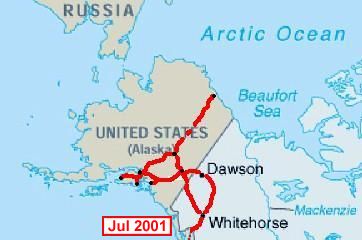 4/7/01 Our boat had almost no foot passengers. The lower
deck was packed with motor homes and 5th wheelers and cars. Our children,
some of the few travelling now without wheels, choosing to leave theirs behind
in Prince Rupert to avoid the high ferry charges. It rained all day spoiling
the long distance mountain vistas. The lower closer mountains were visible
as were a number of humpback whales and porpoises. We pitched the tent alongside
others on the heated solarium deck and with our own food and booze spent a
quiet 4th of July evening.
4/7/01 Our boat had almost no foot passengers. The lower
deck was packed with motor homes and 5th wheelers and cars. Our children,
some of the few travelling now without wheels, choosing to leave theirs behind
in Prince Rupert to avoid the high ferry charges. It rained all day spoiling
the long distance mountain vistas. The lower closer mountains were visible
as were a number of humpback whales and porpoises. We pitched the tent alongside
others on the heated solarium deck and with our own food and booze spent a
quiet 4th of July evening.
5/7/01 Juneau and we departed the boat. This city, Alaska's
capital, is only reachable by boat or plane, there being no roads connecting
it to the rest of the world. While set up for the thousands of visitors
each day from the four or five cruise ships that dock here facilities for
their poorer cousins, travellers on the state run ferry are not so good.
We ended up shuttle biking our children around as the local buses didn't
go to the ferry, campground nor main glacier meaning they would have to get
taxi's at exorbitant tourist prices.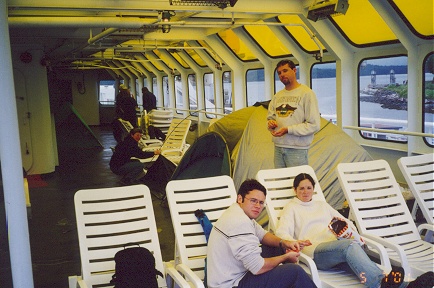 Helicopters and seaplanes constantly dotted the sky and we counted eleven
over the glacier at the same time. This magnificent glacier drops icebergs
into its lake keeping the postcard effect ever changing.
Helicopters and seaplanes constantly dotted the sky and we counted eleven
over the glacier at the same time. This magnificent glacier drops icebergs
into its lake keeping the postcard effect ever changing.
6/7/01 Still raining. The locals tell us summer was two
weeks ago, we missed it. Its salmon running time. They are fighting their
way upstream now to be caught by anglers, or hatcheries to be milked or
to breed naturally. Hatcheries now account for 25% of all salmon. We visited
one with ponds packed with salmon ready to be milked and die to ensure more
salmon for the fishermen and bears. Different cruise ships today, different
people, same helicopters and float planes, same bored staff answering the
same questions, trying to keep fresh but often failing even this early in
the season. The tourist bring a lot of money but the locals don't like them.
They come from cities, but most of the locals like the wild open beauty of
emptiness.
7/7/01 Our 4.15 am departure meant we slept outside the
ferry terminal out of the rain lying on our bedrolls huddled up in sleeping
bags away from the wind. The boat scenery better as occasional clear patches allowed views of glacier
tongues coming out of cloud topped mountains. A humpback slapped the water
many times with its tail as the boat motored past and porpoises seemed to
be everywhere. Off the boat at Skagway, the starting point for the gold rushers
heading to the Yukon for the Klondike gold strike 100 years ago. This dying
ghost town as the gold diminished now experiencing tourist gold. Many of its
old buildings are owned and maintained by the National Parks and their interpretative
displays and tours excellent. A sad farewell to the children as they head
back on the boat and we headed further into Alaska.
The boat scenery better as occasional clear patches allowed views of glacier
tongues coming out of cloud topped mountains. A humpback slapped the water
many times with its tail as the boat motored past and porpoises seemed to
be everywhere. Off the boat at Skagway, the starting point for the gold rushers
heading to the Yukon for the Klondike gold strike 100 years ago. This dying
ghost town as the gold diminished now experiencing tourist gold. Many of its
old buildings are owned and maintained by the National Parks and their interpretative
displays and tours excellent. A sad farewell to the children as they head
back on the boat and we headed further into Alaska.
8/7/01 Still raining, lost count of how many days so far
but the forecast for the next five days here was for rain. Yet 50 km away
from the coast and it stopped and began to clear. The road follows the path
of the gold rush and what took them months took us hours. They had to move
in winter, over the mountains to build boats, to raft the rivers at the first
melt in spring down to the gold fields. Freddie, our New Yorker friend, was
waiting for us in Whitehorse. Eight days to get there from New York. Then
a long day through the Yukon and back into Alaska to Tok. Here the trees grow
short, the ground frozen solid about 4 metres down. The ground everywhere
above that a mushy wet mess of oozing bogs. The road constantly breaking up
as it sinks into the bog. Even the old wooden electricity poles slowly sink
into the ground.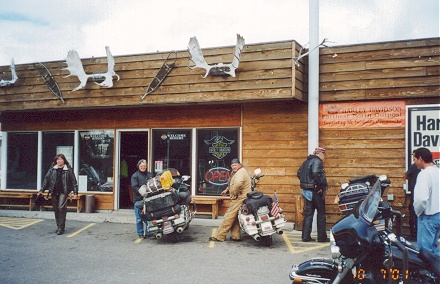
9/7/01 Onto Fairbanks. A large male moose broke the regular
hum of the motorcycle by charging out onto the road just in front of us,
his large feet thumping across the ground. Information on road conditions
from here to Deadhorse/Prudhoe Bay. In this world of exaggeration and dramatization
it is difficult to obtain first hand subjective knowledge. The H-D mechanic
advised us not to go as he has seen many damaged bikes return but others
who had been said that conditions were OK. Bought five days of groceries
ready to go.
10/7/01 The first 70 km sealed, followed by excellent
dirt. Travelling at 70-80 km/hr except where the road was wet from recent
showers, then it was a bit chopped up and slippery. The road follows the
oil pipeline, a massive 1.2 metre diameter snake winding across the landscape.
Suspended a couple of metres off the ground to prevent the 60 degree hot
oil from melting the permafrost and tundra. Across the Yukon River and the
Arctic Circle to where the already stunted trees grow shorter and sparser.
A grey fox was little concerned with our passing as he chose the road edge
as his highway in preference to the boggy tundra. About 400 km and we were
in Coldfoot and half way. The weather had been kind with just a few light
showers.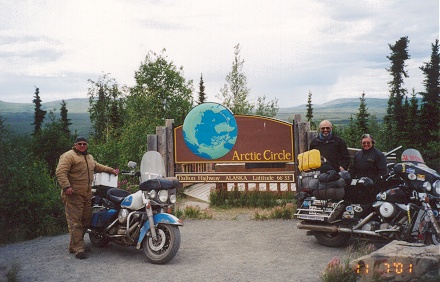
11/7/01 Freddie's motorcycle had been making unusual engine
noises and just 50 km into today he decided to return to Fairbanks rather
than risk being stranded out here. We kept going over the Brooks Mountain
Range where the road had been closed due to snow just a few days earlier
and it was still slushy mud in places. While not overly abundant, wildlife
were there in numbers to keep us looking. A mother fox and five cubs were
playing on the road, three moose grazed as we passed and three large fully
antlered caribou nervously crossed just ahead of us. The truly stunning thing
in this area is the air clarity. Mountains way in the distance seem close,
their details crisp, unspoilt by any dirty air particles. Thunderstorms formed
miles away, can be seen dropping streaks of rain. Before we headed out of
Fairbanks people asked why are we going, "to say we have been there?", that
there was nothing to see. They must not have been looking as there is always
something to see the first time you go somewhere. This area is quite unique
and what you will see is something you probably haven't seen before. We camped at Happy Valley 130 km short of Deadhorse, out on the treeless
tundra, next to a peat darkened stream.
We camped at Happy Valley 130 km short of Deadhorse, out on the treeless
tundra, next to a peat darkened stream.
12/7/01 Yesterday a large rock flung up onto the belt
peeling it from the rear sprocket. We put the belt back on but this morning
on leaving our camp it snapped. A freak break not indicative of the road.
We had broken the belt stone guard in Africa and had forgotten to replace
it, now at our peril. So again roadside a belt replacement, using the spare
that we always carry, three hours, fighting all the time with the mosquitoes.
Heading north the pipeline workers and supply trucks are generally considerate
drivers slowing down or moving over as far as possible as they pass. As the
road is steadily sinking into the tundra much roadwork is needed and while
waiting at a road construction area, two riders, Rocky from Wyoming and Jose
from Spain arrived, also heading to the biker meet. The four of us arrived
at Deadhorse/Prudhoe Bay to strong icy winds. The oil supply town spread
out with dozens of large snow cats on spongy rubber tyres lined up waiting
for the winter freeze to be able to move around again. All the buildings
are on skids, sledded in during winter and now sitting on frozen ground.
Jim and Jamie Clark were already there and were surprised to see others riding
this far to share Jim's 67th birthday. After a great dinner we decided to avoid the $US 100.00 a room price tag
or camping with the town grizzly bears and rode back to Happy Valley 130
km south, in full sunshine at midnight, and seeing two arctic owls and some
caribou along the way.
After a great dinner we decided to avoid the $US 100.00 a room price tag
or camping with the town grizzly bears and rode back to Happy Valley 130
km south, in full sunshine at midnight, and seeing two arctic owls and some
caribou along the way.
13/7/01 The dirt road up here can vary from excellent
100 km/hr hard pack in dry conditions to 60 km/hr chopped up mud in the wet.
The roadwork areas have golf ball to baseball sized stones being rolled about
and can last for 30 km but as they are slowly chip sealing, (stone chips on
asphalt) the road will be getting better each year. Happy Valley, half way
between the Brooks Range and Deadhorse seems to get the best weather. Far
enough inland to avoid most of the ocean fog and low enough to not get the
mountain thunderstorms. We spent two nights there in sunshine, a great hop
off spot for the top. Heading south now, and for the next year and a half.
Some Dall mountain sheep grazed the steep slopes, snow shoe hare ran across
the road and two large male moose grazed on lake weed standing knee deep
in water. We finally ditched the yellow spare petrol drum collected in Congo
as this should be the last time we need to carry extra fuel.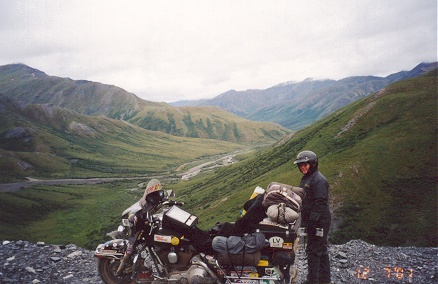 It was given to a motorcyclist heading north. The mosquitoes were bad but
manageable, committing suicide in your cup of coffee or food, dive-bombing
the side of the tent or getting stuck to the oily parts while we changed
the belt. DEET stopped the biting but not the annoying cloud from forming
around us. The worst was probably at Yukon River where we camped tonight.
It was given to a motorcyclist heading north. The mosquitoes were bad but
manageable, committing suicide in your cup of coffee or food, dive-bombing
the side of the tent or getting stuck to the oily parts while we changed
the belt. DEET stopped the biting but not the annoying cloud from forming
around us. The worst was probably at Yukon River where we camped tonight.
14/7/01 The good weather had gone and fog and drizzle
muddied the last 200 km of dirt before clearing in Fairbanks. We bought a
new spare belt at the dealer here and found Freddie about to depart on a
truck with his rear cylinder destroyed. He had made it back to Fairbanks
but found the piston to conrod pin gouging his cylinder after a circlip had
broken. It seems it may have bent the conrod and he chose to truck home.
To ride from New York past the Arctic Circle to within 300 km of the top.
The six who were at the top, plus Lew Waterman had a reunion in Fairbanks
after a successful descent with stories of the trip the conversation. If
not a difficult trip a challenge in its remoteness, weather and 1400 km of
dirt.
15/7/01 Steve and Liz, an Australian couple, were travelling
on a BMW F650 from the bottom of South America to the top of Alaska.
They had made it without problems but on the way down from Prudhoe Bay to
Fairbanks the radiator water entered their oil and they were holed up in Fairbanks
for repairs. They joined us and two other riders who are heading towards
South America to exchange information and discuss this popular long distance
ride. More riders seem to be along this route top to bottom or bottom to
top of the Americas through Central America than anywhere else I know. Washed
everything of the dirt and road grime.
16/7/01 Alaska draws many adventurers like the Japanese
photographer just returning from his fourth summer in the Arctic where he
spends about five weeks photographing wildlife alone, being flown in and flown
out of remote locations. We relaxed and did minor maintenance like plugs,
oil change, new leads. There always seems to be something to do on the motorcycle
as it gets older.
17/7/01 After two sunny days it rained on us all the way
to Denali National Park, Alaska's premier park. No private vehicles allowed
due to the high usage but a series of shuttle buses allow visitors to hop
on and off at will, walk in the back country and camp. We managed to get
two nights camping at Wonder Lake (a rare cancellation as most people book
weeks ahead) and despite the continuing rain managed to spot four grizzly
bears from the bus plus other wildlife. The bear here are smaller than elsewhere
as they have limited protein there being no salmon in the glacial melt rivers.
This also means the bear are predominantly vegetarian thus allowing tourists
safely to walk in the park. Beaver dams and beaver are prevalent nearer to
Wonder Lake and the only disadvantage seems to be the amazing number of aggressive
mosquitoes.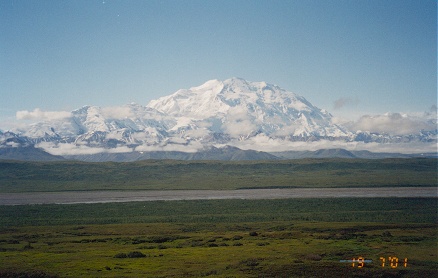
18/7/01 We missed the 8.30 shuttle bus as it was full
and had to dodge swarming mosquitoes for the next three hours but as a consolation
Mt. McKinley/Denali poked its head out of the fog and slowly revealed all
its slopes to stand fully exposed in front of our campground. Rising 5500
metres from the surrounding plains a really impressive sight. The next bus
dropped us at the Eielson area where there is an unusually large concentration
of brown bears. The mother and two cubs we had seen yesterday were still in
the area grazing as were two other larger male bear. We could watch comfortably
in sunshine from a distant hill the eating and resting of all five bear for
hours. One male stalked the female while she rested. The two cubs aware of
his presence took off up the hill disturbing the mother who moved quickly
to higher ground then turned on the pursuing male. Growling, standing on rear
legs and swiping at each other with mouths open the two bears tussled for
a short time then separated. During this exchange we were two lone figures
standing in open tundra just 250 metres away. The bears returned to grazing
and resting and after four hours of watching we left.
19/7/01 The five hour bus ride out of the park plus 400
km motorcycle ride to Anchorage in the rain. I think we are here at the
wrong time. Anchorage is having its wettest July on record and still has
11 days of the month left.
20/7/01 The Anchorage museum with displays on native peoples,
the oil pipeline and the earthquake brought everything we have already seen
in Alaska into perspective. We had an offer of a room from Maxine, a vibrant
octogenarian, and slept off the ground for the first time in a month, and
out of the persistent rain.
21/7/01 Jim and Melinda brightened an otherwise wet ride
to Seward by taking us to lunch at Summit Lake Lodge along the road and
for a couple of drinks overlooking a foggy and cloudy Seward bay. The constant
rain just annoying but coupled with missing magnificent scenery depressing.
The cruise ships are regulars in the bay as are hundreds of motor homes
lined up along the waterfront with barely room to open their doors. Most
are here for the halibut fishing, a large bottom feeder like a sole fish
but often weighing in at over 50 kg. Others are here for the salmon run or
like us just looking.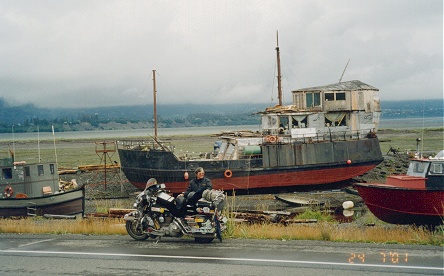
22/7/01 Down to Homer and the weather the same. This Sunday
at the peak salmon run brings anglers by their thousands to line the banks
or fish from rafts and boats the rivers of the Kenai Peninsula. It also
brings bumper to bumper traffic in the afternoon rush to return home.
23/7/01 Halibut, halibut, salmon, salmon, salmon is all
the talk and doing along its coast and rivers. The Homer spit is lined with
charter operators and motor homes, their customers. Our out of the way cheapie
campground is full of the seasonal workers here to milk the fishermen. Uni
students summer vacationing, foreigners illegally working, singles looking
for quick money all wanting jobs on a boat, cleaning fish, deck hand, or cleaning
the boats. Some have to settle for lower paid more mundane work of weeding
vegetable farms or barking logs for log houses, jobs spurned by the locals
who are milking fishermen.
24/7/01 Almost everyone is riding a motorcycle cross countries
these days. Yesterday we met a French couple on a Russian built Ural with sidecar,
looking like a 1940's BMW but only 12 months old and painted army camouflage
colours. They have travelled across Russia and are heading towards Central
America but with only 15,000 km and already a total rebuild of the engine
they are not sure if they will make it. And today we met two young Italian
men just landed in from having also crossed Russia but flew their motorcycles
from Vladivostok to Anchorage. The bike was cheap to fly but for them at
$US 800.00 each quite steep. Back to Anchorage for the night.
Yesterday we met a French couple on a Russian built Ural with sidecar,
looking like a 1940's BMW but only 12 months old and painted army camouflage
colours. They have travelled across Russia and are heading towards Central
America but with only 15,000 km and already a total rebuild of the engine
they are not sure if they will make it. And today we met two young Italian
men just landed in from having also crossed Russia but flew their motorcycles
from Vladivostok to Anchorage. The bike was cheap to fly but for them at
$US 800.00 each quite steep. Back to Anchorage for the night.
25/7/01 To Valdez and we have come the entire 1200 km
length of the Alaskan pipeline from Prudhoe Bay. It's here where the oil
is shipped around the world. It is here where the Exxon Valdez spilt over
10 million gallons of crude oil into Prince William Sound 12 years ago bringing
this town to prominence all over the world. The town grew from a normal 3500
population to 13500 population almost overnight flooding money into the small
place. Today there is no sign of these problems and our campground once again
packed with motor home fishermen indicating the ecology has recovered.
26/7/01 Two cruise ships fill and empty the town daily
of three thousand visitors. Frequenting the museum and buying souvenirs
for back home. The motor homers are fishing the salmon run up to the hatchery.
The hatchery already is full of breeding fish and the remainder that weren't
caught by professional fisherman on their way home are now being caught
by recreational fishermen. The fish have nowhere to go, instincts door at
the hatchery closed so they will mill around in their thousands near its
entrance waiting to die sexually unfulfilled. A motor homer with his freezers
full still fishes for the sport, such is the addiction, and allows us all
we want rather than throwing them back. Tired of fishing for the day he even
fillets them for us and seeking company we are invited inside for a hot chocolate.
These full size coaches line the shore for the summer migrating south for
the winter only to return again next year with the salmon.
27/7/01 Heading out of Alaska through Glennallen, Tok
and across the "Top of the World Highway" to the Canadian border. This road
much improved in recent years doesn't hold the horror stories it used
to. Now half sealed, half dirt on the Alaskan side from Tok to the border
and crumbling chip seal on the Canadian side it supports the bus RV crowd
but gets a bit soft or slippery in the wet. Despite the weather we had a
great time in Alaska fulfilling or exceeding our expectations of wilderness,
remoteness, wildlife and friendly no-nonsense, come as you are, locals.
Move with us to Canada
, or go to our next visit to the United States
of America .
 4/7/01 Our boat had almost no foot passengers. The lower
deck was packed with motor homes and 5th wheelers and cars. Our children,
some of the few travelling now without wheels, choosing to leave theirs behind
in Prince Rupert to avoid the high ferry charges. It rained all day spoiling
the long distance mountain vistas. The lower closer mountains were visible
as were a number of humpback whales and porpoises. We pitched the tent alongside
others on the heated solarium deck and with our own food and booze spent a
quiet 4th of July evening.
4/7/01 Our boat had almost no foot passengers. The lower
deck was packed with motor homes and 5th wheelers and cars. Our children,
some of the few travelling now without wheels, choosing to leave theirs behind
in Prince Rupert to avoid the high ferry charges. It rained all day spoiling
the long distance mountain vistas. The lower closer mountains were visible
as were a number of humpback whales and porpoises. We pitched the tent alongside
others on the heated solarium deck and with our own food and booze spent a
quiet 4th of July evening.  Helicopters and seaplanes constantly dotted the sky and we counted eleven
over the glacier at the same time. This magnificent glacier drops icebergs
into its lake keeping the postcard effect ever changing.
Helicopters and seaplanes constantly dotted the sky and we counted eleven
over the glacier at the same time. This magnificent glacier drops icebergs
into its lake keeping the postcard effect ever changing.  The boat scenery better as occasional clear patches allowed views of glacier
tongues coming out of cloud topped mountains. A humpback slapped the water
many times with its tail as the boat motored past and porpoises seemed to
be everywhere. Off the boat at Skagway, the starting point for the gold rushers
heading to the Yukon for the Klondike gold strike 100 years ago. This dying
ghost town as the gold diminished now experiencing tourist gold. Many of its
old buildings are owned and maintained by the National Parks and their interpretative
displays and tours excellent. A sad farewell to the children as they head
back on the boat and we headed further into Alaska.
The boat scenery better as occasional clear patches allowed views of glacier
tongues coming out of cloud topped mountains. A humpback slapped the water
many times with its tail as the boat motored past and porpoises seemed to
be everywhere. Off the boat at Skagway, the starting point for the gold rushers
heading to the Yukon for the Klondike gold strike 100 years ago. This dying
ghost town as the gold diminished now experiencing tourist gold. Many of its
old buildings are owned and maintained by the National Parks and their interpretative
displays and tours excellent. A sad farewell to the children as they head
back on the boat and we headed further into Alaska. 

 We camped at Happy Valley 130 km short of Deadhorse, out on the treeless
tundra, next to a peat darkened stream.
We camped at Happy Valley 130 km short of Deadhorse, out on the treeless
tundra, next to a peat darkened stream.  After a great dinner we decided to avoid the $US 100.00 a room price tag
or camping with the town grizzly bears and rode back to Happy Valley 130
km south, in full sunshine at midnight, and seeing two arctic owls and some
caribou along the way.
After a great dinner we decided to avoid the $US 100.00 a room price tag
or camping with the town grizzly bears and rode back to Happy Valley 130
km south, in full sunshine at midnight, and seeing two arctic owls and some
caribou along the way.  It was given to a motorcyclist heading north. The mosquitoes were bad but
manageable, committing suicide in your cup of coffee or food, dive-bombing
the side of the tent or getting stuck to the oily parts while we changed
the belt. DEET stopped the biting but not the annoying cloud from forming
around us. The worst was probably at Yukon River where we camped tonight.
It was given to a motorcyclist heading north. The mosquitoes were bad but
manageable, committing suicide in your cup of coffee or food, dive-bombing
the side of the tent or getting stuck to the oily parts while we changed
the belt. DEET stopped the biting but not the annoying cloud from forming
around us. The worst was probably at Yukon River where we camped tonight.


 Yesterday we met a French couple on a Russian built Ural with sidecar,
looking like a 1940's BMW but only 12 months old and painted army camouflage
colours. They have travelled across Russia and are heading towards Central
America but with only 15,000 km and already a total rebuild of the engine
they are not sure if they will make it. And today we met two young Italian
men just landed in from having also crossed Russia but flew their motorcycles
from Vladivostok to Anchorage. The bike was cheap to fly but for them at
$US 800.00 each quite steep. Back to Anchorage for the night.
Yesterday we met a French couple on a Russian built Ural with sidecar,
looking like a 1940's BMW but only 12 months old and painted army camouflage
colours. They have travelled across Russia and are heading towards Central
America but with only 15,000 km and already a total rebuild of the engine
they are not sure if they will make it. And today we met two young Italian
men just landed in from having also crossed Russia but flew their motorcycles
from Vladivostok to Anchorage. The bike was cheap to fly but for them at
$US 800.00 each quite steep. Back to Anchorage for the night.